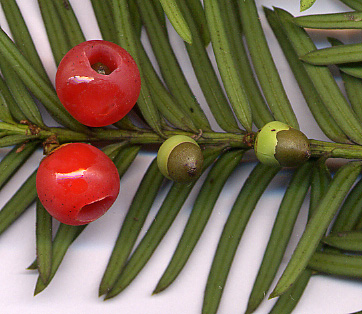Word of the Day
Yew (yoo)
An evergreen tree of the northern hemisphere with needlelike leaves
Common clues: Wood in archery bows; Longbow wood; Archery bow wood
Crossword puzzle frequency: 2 times a year
Frequency in English language: 16689 / 86800
News: Getting to know all about yew
Taxus baccata is a conifer native to western, central and southern Europe, northwest Africa, northern Iran and southwest Asia. Originally and still widely known in English as just Yew, the later discovery of other very similar related species has led to qualification as European Yew, Common Yew or English Yew where detail of which species of Taxus is required. The word yew is from Proto-Germanic *iwa-, possibly originally a loanword from Gaulish ivos, compare Irish eo, Welsh ywen, French if; see Eihwaz for a discussion). Baccata is Latin for bearing berries.

In the ancient Celtic world, the yew tree (*eburos) had extraordinary importance; a passage by Caesar narrates that Catuvolcus, chief of the Eburones, virtually "sons of the yew", poisoned himself with yew rather than submit to Rome (Gallic Wars 6: 31). Similarly, Florus notes that when the Cantabrians were under siege by the legate Gaius Furnius in 22 BC, most of them took their lives either by the sword or by fire or by a poison extracted ex arboribus taxeis, that is, from the yew tree (2: 33, 50-51). In Hispania, Prudentius (Contra Simacum 2: 1005-1011) and Martin of Braga in Visigothic times (De correctione rusticorum 8) denounced the fact that the Hispanic country folk still worshipped trees and sacred stones (Simón 2005).
The yew is often found in churchyards from England and Ireland to the Asturias (Simón ref); some of these trees are exceptionally large (over 3 m diameter) and likely to be over 2,000 years old, long predating the churches they are beside and betokening an earlier sacred site. Many believe that the enormous sacred evergreen at the pagan Temple at Uppsala was a yew. The Christian church commonly found it expedient to take over these existing sacred sites for churches. It is sometimes suggested that these were planted as a symbol of long life or trees of death. An explanation that the yews were planted to discourage farmers and drovers from letting their animals wander into the burial grounds, with the poisonous foliage being the disincentive, may be intentionally prosaic.
Yew is also associated with Wales because of the longbow, an early weapon of war, developed in Wales. Yew is the wood of choice for longbow making and the bows are constructed so that the heartwood of yew is on the inside of the bow while the sapwood is on the outside. This takes advantage of the natural properties of yew wood since the heartwood is able to withstand compression while the sapwood is elastic and allows the bow to stretch. Both tend to return to their original straightness when the arrow is released.
This article is licensed under the GNU Free Documentation License. It uses material from the Wikipedia article "Yew".
|
|